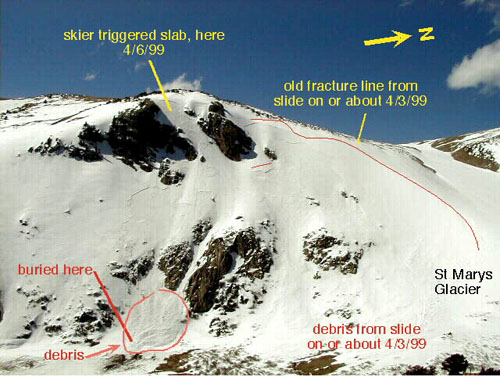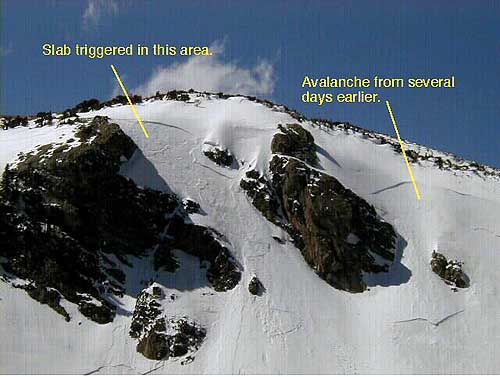
A lucky backcountry skier survived a short burial at St. Mary’s Glacier by the quick action of a couple of avalanche-savvy snowboarders. At about 10:30 AM two skiers stood above the steep slopes above St. Mary’s Lake. The first skier ventured onto the slope and when he made his first turn, he triggered a shallow soft-slab avalanche. (He was probably carried over the cliff band seen in the photo.)


About 150 yards to the south of the avalanche a couple of well-equipped snowboarders had just ridden down along the edge of the trees and were getting ready to hike back up hill for another run. Equipped with transceivers and shovels the pair had decided not to tackle the glacier area but to ride in the less-steep terrain just south of the lake. They saw the avalanche and watched the skier disappear under the snow just before the snow quickly piled up at the base of the steep slope.
With a good last-seen-area noted the snowboarders quickly rode down through the trees toward the lake and started a shallow traverse toward the debris. Getting to the flats at the lake the pair ran the last few yards onto the debris. At the last seen area they found the victim's glasses and quickly started digging.
They picked the right spot and soon hit the buried man. His face was uncovered within 5 minutes after the slide. The skier was buried face down with his head under about one foot of snow. His legs and feet were even deeper. (Looking at the hole, his feet were buried about 4 feet). The victim's friend carefully skied down the bed surface of the avalanche to help get his friend out. While the man was being dug out the Clear County Sheriff's Office was notified and local rescue teams responded.
Battered but okay the man and his friend quietly retreated to their vehicle and avoided rescuers and questions. Fortunately, one of the rescuers called our office to report the accident. (Thank you!)
This relatively small soft-slab avalanche was classified as an SS-AS-2-0. It was triggered by the skier on a steep, 44-degree slope that faced east-northeast. The fracture line was only about 1-foot deep and was no more than 75 feet across; however, as the snow spilled over the small cliff the avalanche did entrain additional snow to the south. At its widest point the avalanche was only about no more than 200 feet across. Before stopping the snow channeled through some rocks at the bottom of the track creating a relatively small deep runout zone. The victim was likely carried over these rocks. The slide fell 580 vertical feet. The alpha angle was a steep 39 degrees. Typical alpha angles--the angle from the end of the debris to the top of the fracture line--for Colorado avalanches are about 26 degrees.
The avalanche ran on an old icy-snow surface. Conditions at the time of the avalanche were very warm and the recent snow from the weekend was just turning moist. This old layer had already turned gray and dirty from the warm and dry conditions experienced in March. This avalanche could not be classified as a wet slab as there was no liquid water present in the slab at the time of the avalanche.
Though no new snow had fallen in the past several days conditions were ripe for an avalanche on this particular slope. Nature provided fair warning. The slope immediately to the north--the glacier proper--had recently avalanched; the fracture lines and debris were plainly visible. This avalanche likely released over the weekend as only a portion of the fracture line was covered by freshly drifted snow. Most of the fracture lines and old bed surface snow were obvious. This recent slide occurred on an identical slope as to elevation, aspect and slope angle.
Certainly, a recent avalanche is the best clue of avalanche danger but there was another clue--though an often neglected clue--of danger: a sun-warmed slope. Of course the sun warms slopes in the spring time, but the avalanche danger increases when there is fresh/recent snow, often topping an icy melt-freeze crust, on steep, sun-exposed slopes. In Colorado these sun-warmed slopes are more of an avalanche problem in the spring and early summer then in mid winter. Here is why sun-warmed slopes can be avalanche-problem slopes.
Spring and early summer snowstorms can still deposit cold, winter-like snow. If this new snow falls onto an old, icy sun crust, the new snow tends not to adhere to this crust. While snow is a lousy thermal conductor, the sun's energy can quickly warm the top several inches of the new snow. This warming occurs first in the early mornings on steep east-facing slopes, and the warming on other aspects from south through west as the sun tracks across the sky. As the snow warms, the slab softens and stresses caused by gravity between the warmer surface snow and the colder sub-surface snow increases. As these stresses approach the snow's strength the slab becomes more unstable. When stresses are equal or exceed the strength avalanches result, or avalanches can release even sooner when the additional stress caused by a person tips this tenuous balance. Be wary of fresh snow over old crusts on steep slopes bathed in bright sunshine, even early in the morning. The fresh snow does not need to become wet for avalanches to occur.
One last thing...this buried skier was very lucky to be rescued so quickly. He and his friend did not carry avalanche rescue equipment. Had the two avalanche-ready snowboarders not been so close by, this story may have ended tragically. It is also remarkable he was able to walk away from this avalanche after tumbling through the rocks. He cheated death and walked away...he ought to buy a lottery ticket, soon!